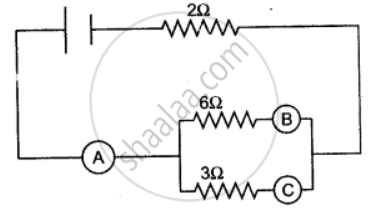Advertisements
Advertisements
प्रश्न
A current of 100 mA. flows through a wire. The charge on an electron is 1.6 × 10-19 C. Find the number of electrons passing per second through the cross-section of the conductor.
उत्तर
Given: I = 100mA = 100 × 10-3 A = 0.1A, e = 1.6 × 10-19 C
Let n electrons are passing per second. Charge on one electron = e
Total charge passed in one second = ne
Thus, i = ne or
n = `"i"/"e" = 0.1/(1.6 xx 10^-19) = 6.25 xx 10^17`.
APPEARS IN
संबंधित प्रश्न
State two causes of energy loss in a transformer.
Name a device that help to measure the potential difference across a conductor.
The device used for measuring potential difference is known as:
Name the law which relates the current in a conductor to the potential difference across its ends.
A p.d. of 10 V is needed to make a current of 0.02 A flow through a wire. Wire p.d. is needed to make a current of 250 mA flow through the same wire?
Water in the waterfall flows from a higher level to the lower level because of ____________.
Draw a graph of Potential difference (V) versus Current (I) for an ohmic resistor. How can you find the resistance of the resistor from this graph?
In the figure given below, A, B and C are three ammeters. The ammeter B reads 0.5A. (All the ammeters have negligible resistance.)

Calculate:
(i) the readings in the ammeters A and C.
(ii) the total resistance of the circuit.
Two bulbs are marked 100 W, 220 V and 60 W, 110 V. Calculate the ratio of their resistances.
Electric potential is a ____________.
